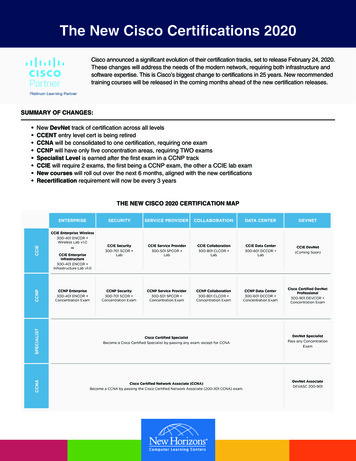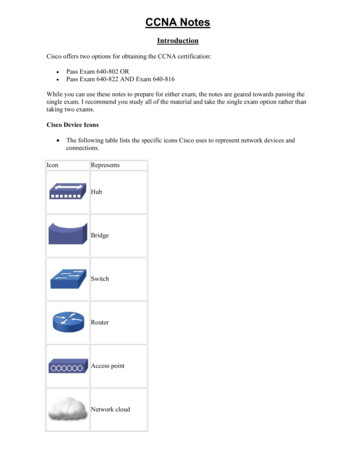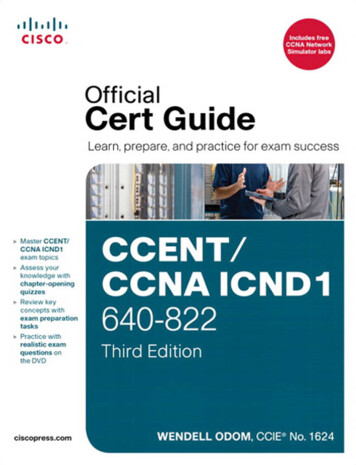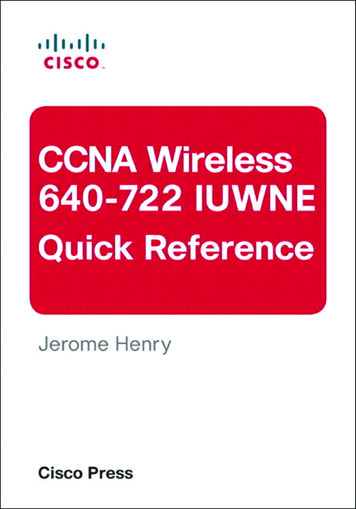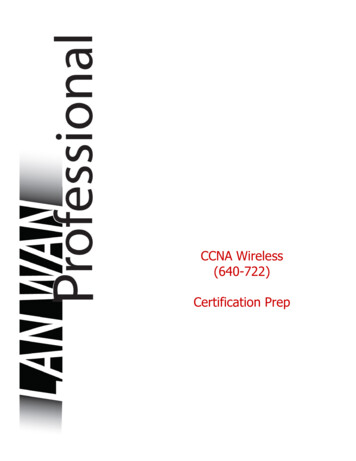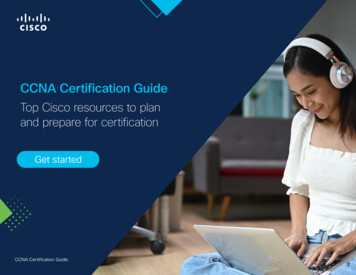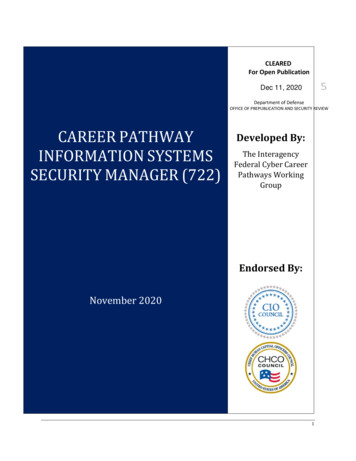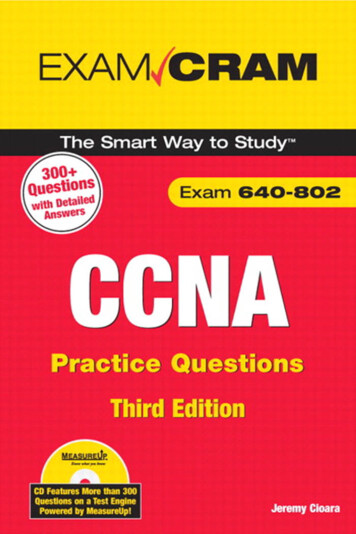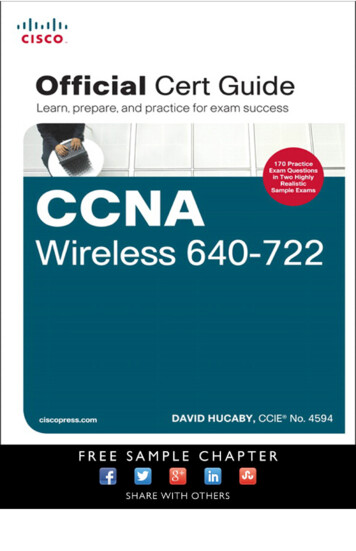
Transcription
CCNA Wireless 640-722Official Cert GuideDavid HucabyCisco Press800 East 96th StreetIndianapolis, IN 46240
iiCCNA Wireless 640-722 Official Cert GuideCCNA Wireless 640-722 Official Cert GuideDavid HucabyCopyright 2014 Cisco Systems, Inc.Published by:Cisco Press800 East 96th StreetIndianapolis, IN 46240 USAAll rights reserved. No part of this book may be reproduced or transmitted in any form or by any means,electronic or mechanical, including photocopying, recording, or by any information storage and retrievalsystem, without written permission from the publisher, except for the inclusion of brief quotations in areview.Printed in the United States of AmericaSecond Printing January 2015Library of Congress Control Number: 2014931706ISBN-13: 978-1-58720-562-0ISBN-10: 1-58720-562-9Warning and DisclaimerThis book is designed to provide information about preparing for the CCNA Wireless 640-722 exam.Every effort has been made to make this book as complete and as accurate as possible, but no warrantyor fitness is implied.The information is provided on an “as is” basis. The author, Cisco Press, and Cisco Systems, Inc., shallhave neither liability nor responsibility to any person or entity with respect to any loss or damagesarising from the information contained in this book or from the use of the discs or programs that mayaccompany it.The opinions expressed in this book belong to the author and are not necessarily those of Cisco Systems,Inc.Trademark AcknowledgmentsAll terms mentioned in this book that are known to be trademarks or service marks have been appropriately capitalized. Cisco Press or Cisco Systems, Inc. cannot attest to the accuracy of this information. Useof a term in this book should not be regarded as affecting the validity of any trademark or service mark.
iiiSpecial SalesFor information about buying this title in bulk quantities, or for special sales opportunities (which mayinclude electronic versions; custom cover designs; and content particular to your business, training goals,marketing focus, or branding interests), please contact our corporate sales department at corpsales@pearsoned.com or (800) 382-3419.For government sales inquiries, please contact governmentsales@pearsoned.com.For questions about sales outside the U.S., please contact international@pearsoned.com.Feedback InformationAt Cisco Press, our goal is to create in-depth technical books of the highest quality and value. Each bookis crafted with care and precision, undergoing rigorous development that involves the unique expertiseof members from the professional technical community.Readers’ feedback is a natural continuation of this process. If you have any comments regarding how wecould improve the quality of this book, or otherwise alter it to better suit your needs, you can contact usthrough e-mail at feedback@ciscopress.com. Please make sure to include the book title and ISBN in yourmessage.We greatly appreciate your assistance.Publisher: Paul BogerBusiness Operation Manager, Cisco Press: Jan CornelssenAssociate Publisher: Dave DusthimerManager Global Certification: Sean DonovanExecutive Editor: Mary Beth RaySenior Development Editor: Christopher ClevelandManaging Editor: Sandra SchroederCopy Editor: Keith ClineProject Editor: Seth KerneyTechnical Editor: Jerome HenryEditorial Assistant: Vanessa EvansProofreader: Jess DeGabrieleCover Designer: Mark ShirarIndexer: Tim WrightComposition: Jake McFarland
ivCCNA Wireless 640-722 Official Cert GuideAbout the AuthorDavid Hucaby, CCIE No. 4594, is a network architect for the University of Kentucky,where he works with academic and healthcare networks based on the Cisco UnifiedWireless Network products. David has bachelor’s and master’s degrees in electrical engineering from the University of Kentucky. He is the author of several Cisco Press titles,including CCNP SWITCH Exam Certification Guide; Cisco LAN Switching VideoMentor; CCNP Security FIREWALL Exam Certification Guide; Cisco ASA, PIX,and FWSM Firewall Handbook, Second Edition; and Cisco Firewall Video Mentor.David lives in Kentucky with his wife, Marci, and two daughters.
vAbout the Technical ReviewerJerome Henry, CCIE Wireless No. 24750, is technical marketing engineer in theWireless Enterprise Networking Group at Cisco systems. Jerome has close to 15 yearsexperience teaching technical Cisco courses in more than 15 different countries and 4different languages, to audiences ranging from bachelor degree students to networkingprofessionals and Cisco internal system engineers.Focusing on his wireless experience, Jerome joined Cisco in 2012. Before that time, hewas consulting and teaching Heterogeneous Networks and Wireless Integration withthe European Airespace team, which was later acquired by Cisco to become their mainwireless solution. He then spent several years with a Cisco Learning partner, developing wireless courses, and working on training material for new wireless technologies. Inaddition to his CCIE Wireless certification, Jerome is a certified wireless networkingexpert (CWNE #45) and has developed several Cisco courses focusing on wireless topics (IUWNE, IUWMS, IUWVN, CUWSS, IAUWS, LBS, CWMN lab guide, and so on)and authored several Wireless books (IUWMS, CUWSS Quick Reference, and so on).Jerome is also an IEEE 802.11 group member and participant of Wi-Fi Alliance working groups. With more than 10000 hours in the classroom, Jerome was awarded the ITTraining Award best Instructor silver medal in 2009. He is based in the Research TrianglePark in North Carolina.
viCCNA Wireless 640-722 Official Cert GuideDedicationsAs always, this book is dedicated to the most important people in my life: my wife,Marci, and my two daughters, Lauren and Kara. Their love, encouragement, and support carry me along. I’m so grateful to God, who gives endurance and encouragement(Romans 15:5), and who has allowed me to enjoy networking and work on projects likethis.I would also like to dedicate this book to the memory of my father-in-law, ErmelWilson. He helped me appreciate the simpler things in life—the outdoors, hikes in thewoods, and snow.
viiAcknowledgmentsIt has been my great pleasure to work on another Cisco Press project. I enjoy the networking field very much, and technical writing even more. And more than that, I’mthankful for the joy and inner peace that Jesus Christ gives, making everything moreabundant and worthwhile. As much as I enjoy learning about wireless networking (there’sno end to it!), I realize that God created the original wireless connection that has nodistance limits, unlimited capacity for clients (there’s always room for one more), is trustworthy, always available everywhere, and connects directly to the Source: prayer!I’ve now been writing Cisco Press titles continuously for what will soon be 15 years. Ihave physically worn out several laptop keyboards and probably several Cisco Press editors in the process. It has been a great pleasure to work with Chris Cleveland and MaryBeth Ray. I should have a certification in schedule slipping by now. Keith Cline and SethKerney have been great to work with and have made the whole review process smoothand efficient. One important part of the book I never get to see is the index. I’m gratefulthat Tim Wright worked on this one.I am very grateful for the insight, knowledge, and helpful comments that Jerome Henryhas provided. He is a great resource for wireless networking expertise and training.Jerome’s input has made this a more well-rounded book and me a more educated author.Finally, I have enjoyed the good discussions with my dad, Reid Hucaby, a fellow EE anda seasoned RF engineer, that this book has prompted about all things wireless.
viiiCCNA Wireless 640-722 Official Cert GuideContents at a GlanceIntroductionxixChapter 1RF Signals and Modulation 3Chapter 2RF Standards 37Chapter 3RF Signals in the Real World 67Chapter 4Understanding Antennas 85Chapter 5Wireless LAN Topologies 105Chapter 6Understanding 802.11 Frame Types 123Chapter 7Planning Coverage with Wireless APs 147Chapter 8Using Autonomous APs 163Chapter 9Understanding the CUWN Architecture 181Chapter 10Initial Controller Configuration 201Chapter 11Understanding Controller Discovery 221Chapter 12Understanding Roaming 239Chapter 13Understanding RRM 259Chapter 14Wireless Security Fundamentals 281Chapter 15Configuring a WLAN 307Chapter 16Implementing a Wireless Guest Network 323Chapter 17Understanding Wireless Clients 335Chapter 18Managing Wireless Networks with WCS 359Chapter 19Dealing with Wireless Interference 383Chapter 20Troubleshooting WLAN Connectivity 401Chapter 21Maintaining Controllers 427Chapter 22Final Review 447Appendix AAnswers to “Do I Know This Already?” Quizzes 457Appendix BModulation and Coding Schemes 473Key Terms Glossary 481Index 494
ixContentsIntroductionChapter 1xixRF Signals and Modulation3“Do I Know This Already?” Quiz3Foundation Topics 7Comparing Wired and Wireless Networks 7Understanding Basic Wireless Theory 8Understanding Frequency 10Understanding Phase 14Measuring Wavelength 14Understanding RF Power and dB 15Important dB Facts to Remember 17Comparing Power Against a Reference: dBm 19Measuring Power Changes Along the Signal Path 20Understanding Power Levels at the Receiver 23Carrying Data Over an RF Signal 24FHSS26DSSS271-Mbps Data Rate 282-Mbps Data Rate 295.5-Mbps Data Rate 3011-Mbps Data Rate 30OFDM31Modulation Summary 32Exam Preparation Tasks 34Review All Key Topics 34Key TermsChapter 2RF Standards3437“Do I Know This Already?” Quiz37Foundation Topics 41Regulatory Bodies 41ITU-R41FCC42ETSI44Other Regulatory Bodies 45IEEE Standards Body 45802.11 Channel Use 47Channels in the 2.4-GHz ISM Band 47Channels in the 5-GHz U-NII Bands 49
xCCNA Wireless 640-722 Official Cert GuideIEEE 802.11 Standards 51802.11-1997 52802.11b 52802.11g 52802.11a 54802.11n 55Channel Aggregation57Spatial Multiplexing58MAC Layer Efficiency59Transmit Beam Forming (T BF)60Maximal-Ratio Combining 61802.11n Modulation and Coding Schemes 61Beyond 802.11nWi-Fi Alliance6263Exam Preparation TasksReview All Key TopicsDefine Key TermsChapter 3646464RF Signals in the Real World“Do I Know This Already?” Quiz6767Foundation Topics 70Interference 70Co-Channel Interference 70Neighboring Channel Interference 71Non-802.11 Interference 72Free Space Path Loss 72Mitigating the Effects of Free Space Path Loss 74Effects of Physical Objects 76Reflection 76Absorption 78Scattering 78Refraction 79Diffraction 80Fresnel Zones 80Exam Preparation Tasks 83Review All Key Topics 83Define Key Terms 83Chapter 4Understanding Antennas 85“Do I Know This Already?” Quiz 85Foundation Topics 88
xiAntenna Characteristics88Radiation Patterns 88Gain91Beamwidth 92Polarization 92Antenna Types93Omnidirectional Antennas 94Directional Antennas 97Antenna Summary101Adding Antenna AccessoriesExam Preparation Tasks103Review All Key TopicsDefine Key TermsChapter 5101103103Wireless LAN Topologies105“Do I Know This Already?” Quiz105Foundation Topics 108Types of Wireless Networks 108Wireless LAN Topologies 109Basic Service Set 110Distribution System 112Extended Service Set 114Independent Basic Service Set 115Other Wireless Topologies 116Repeater 116Workgroup Bridge 117Outdoor Bridge 118Mesh Network 119Exam Preparation Tasks 120Review All Key Topics 120Define Key Terms 120Chapter 6Understanding 802.11 Frame Types 123“Do I Know This Already?” Quiz 123802.11 Frame Format 126802.11 Frame Addressing 128Accessing the Wireless Medium 130Carrier Sense 131Collision Avoidance 132802.11 Frame Types 134Management Frames 134
xiiCCNA Wireless 640-722 Official Cert GuideControl Frames 135Data Frames 136Client Housekeeping 136A Client Scans for APs 137A Client Joins a BSS 138A Client Leaves a BSS 139A Client Moves Between BSSs 140A Client Saves Power 142Exam Preparation Tasks 145Review All Key Topics 145Define Key Terms 145Chapter 7Planning Coverage with Wireless APs 147“Do I Know This Already?” Quiz 147AP Cell Size 150Tuning Cell Size with Transmit Power 150Tuning Cell Size with Data Rates 152Adding APs to an ESS 153The Roaming Process 155WLAN Channel Layout 157Exam Preparation Tasks 161Review All Key Topics 161Define Key Terms 161Chapter 8Using Autonomous APs 163“Do I Know This Already?” Quiz 163Foundation Topics 166Autonomous Architecture 166Configuring an Autonomous AP 167Connecting the AP 167Configuring the AP 170Converting an Autonomous AP 174Using the Autonomous to Lightweight Mode Upgrade Tool 174Converting an Autonomous AP Manually 176Exam Preparation Tasks 178Review All Key Topics 178Define Key Terms 178Chapter 9Understanding the CUWN Architecture 181“Do I Know This Already?” Quiz 181Foundation Topics 184A Distributed Architecture 184
xiiiA Centralized Architecture186Split-MAC Architecture 188Traffic Patterns in a CUWN 190CUWN Building Blocks 192Cisco Wireless LAN Controllers 192Cisco Lightweight APs 194CUWN Management197Exam Preparation Tasks198Review All Key TopicsChapter 10198Initial Controller Configuration201“Do I Know This Already?” Quiz201Foundation Topics 204Connecting the Controller 204Using Controller Ports 204Using Controller Interfaces 206Running the Initial Setup Wizard 208Initial Setup with the Web Interface 208Initial Setup with the CLI 216Exam Preparation Tasks 218Review All Key Topics 218Define Key Terms 218Chapter 11Understanding Controller Discovery 221“Do I Know This Already?” Quiz221Foundation Topics 224Discovering a Controller 224AP States224Discovering a WLCSelecting a WLC226227Designing High Availability228Detecting a Controller FailureBuilding Redundancy231N 1 Redundancy231N N Redundancy232N N 1 Redundancy232AP SSO Redundancy233Exam Preparation Tasks 235Review All Key Topics 235Define Key Terms 236230
xivCCNA Wireless 640-722 Official Cert GuideChapter 12Understanding Roaming 239“Do I Know This Already?” Quiz 239Foundation Topics 242Roaming with Autonomous APs 242Intracontroller Roaming 244Intercontroller Roaming 246Layer 2 Roaming 247Layer 3 Roaming 248Using Mobility Groups 252Exam Preparation Tasks 256Review All Key Topics 256Define Key Terms 256Chapter 13Understanding RRM 259“Do I Know This Already?” Quiz 259Foundation Topics 262Configuring 802.11 Support 262Configuring Data Rates 263Configuring 802.11n Support 264Understanding RRM 265RF Groups 267TPCDCA269272Coverage Hole Detection 274Manual RF Configuration 276Verifying RRM Results 278Exam Preparation Tasks 279Review All Key Topics 279Define Key Terms 279Chapter 14Wireless Security Fundamentals 281“Do I Know This Already?” Quiz 282Foundation Topics 285Anatomy of a Secure Connection 285Authentication 286Message Privacy 287Message Integrity 288Intrusion Protection 289Wireless Client Authentication Methods 290Open AuthenticationWEP291290
xv802.1x/EAP 292LEAP294EAP-FAST 294PEAP294EAP-TLS295Wireless Privacy and Integrity Methods 295TKIPCCMP295296WPA and WPA2297Securing Management Frames with MFPConfiguring Wireless Security298298Configuring WPA or WPA2 Personal299Configuring WPA2 Enterprise Mode 300Configuring WPA2 Enterprise with Local EAP 302Exam Preparation Tasks 305Review All Key Topics 305Define Key Terms 305Chapter 15Configuring a WLAN 307“Do I Know This Already?” Quiz307Foundation Topics 309WLAN Overview309Configuring a WLAN310Configuring a RADIUS Server310Creating a Dynamic Interface312Creating a New WLAN313Configuring WLAN SecurityConfiguring WLAN QoS315317Configuring Advanced WLAN SettingsFinalizing WLAN ConfigurationExam Preparation Tasks319320Review All Key TopicsChapter 16318320Implementing a Wireless Guest Network“Do I Know This Already?” Quiz323Foundation Topics 325Guest Network Overview 325Configuring a Guest Network 326Scaling the Guest Network 329Exam Preparation Tasks 332Review All Key Topics 332Define Key Terms 332323
xviCCNA Wireless 640-722 Official Cert GuideChapter 17Understanding Wireless Clients 335“Do I Know This Already?” Quiz335Foundation Topics 338Configuring Common Wireless Clients 338Windows 7 and 8Intel PROSetAndroid338341345Apple OS X 346Cisco AnyConnect 348Cisco Compatible Extensions 352Exam Preparation Tasks 356Review All Key Topics 356Define Key Terms 356Chapter 18Managing Wireless Networks with WCS 359“Do I Know This Already?” Quiz 359Foundation Topics 362WCS Overview 362Alarm Summary Dashboard 364Main Navigation Area 366WCS Home Area 366Using WCS to Configure Devices 368Using WCS Maps 370Displaying Maps 370Manipulating APs on Maps 373Viewing Information on Maps 375Generating Reports 377Exam Preparation Tasks 381Review All Key Topics 381Chapter 19Dealing with Wireless Interference 383“Do I Know This Already?” Quiz 383Understanding Types of Interference 386Bluetooth 386ZigBee387Cordless Phones 388Microwave Ovens 388WiMAX388Other Devices389
xviiUsing Cisco CleanAir to Manage Interference 390Enabling CleanAir 392Air-Quality Index 394Using Event-Driven RRM 396Exam Preparation Tasks 397Review All Key Topics 397Define Key Terms 398Chapter 20Troubleshooting WLAN Connectivity 401“Do I Know This Already?” Quiz 401Foundation Topics 405Troubleshooting Client Connectivity 405Troubleshooting Clients from the Controller 406Performing a Link Test 411Debugging a Client 412Troubleshooting Clients from WCS/NCS 415Troubleshooting AP Connectivity 420Verifying AP-to-WLC Connectivity 420Verifying AP-to-Network Connectivity 422Exam Preparation Tasks 425Review All Key Topics 425Chapter 21Maintaining Controllers 427“Do I Know This Already?” Quiz 427Accessing WLC and AP Management Interfaces 430Accessing APs 432Maintaining WLC Code Images 434Maintaining WLC Configurations 437Working with WLC Logs 439Exam Preparation Tasks 444Review All Key Topics 444Chapter 22Final Review 447Advice About the Exam Event 447Learn the Question Types Using the Cisco Certification ExamTutorial 447Think About Your Time Budget 452Other Pre-Exam Suggestions 453Final Thoughts 455
xviiiCCNA Wireless 640-722 Official Cert GuideAppendix AAnswers to “Do I Know This Already?” Quizzes 457Chapter 1 457Chapter 2 458Chapter 3 459Chapter 4 459Chapter 5 460Chapter 6 461Chapter 7 461Chapter 8 462Chapter 9 463Chapter 10 464Chapter 11 464Chapter 12 465Chapter 13 466Chapter 14 467Chapter 15 467Chapter 16 468Chapter 17 468Chapter 18 469Chapter 19 469Chapter 20 470Chapter 21 471Appendix BModulation and Coding Schemes 473Key Terms Glossary 481Index 494
xixIcons Used in This BookCommand Syntax ConventionsThe conventions used to present command syntax in this book are the same conventionsused in the IOS Command Reference. The Command Reference describes these conventions as follows: Boldface indicates commands and keywords that are entered literally as shown. Inactual configuration examples and output (not general command syntax), boldfaceindicates commands that are manually input by the user (such as a show command). Italic indicates arguments for which you supply actual values. Vertical bars ( ) separate alternative, mutually exclusive elements. Square brackets ([ ]) indicate an optional element. Braces ({ }) indicate a required choice. Braces within brackets ([{ }]) indicate a required choice within an optional element.
xxCCNA Wireless 640-722 Official Cert GuideIntroductionWelcome to the world of Cisco Certified Network Associate (CCNA) Wireless! As technology continues to evolve, wireless technologies are finding their way to the forefront.This clearly indicates the progression from a fixed wired type of connectivity to a morefluid, mobile workforce that can work when, where, and how they want. Regardless ofyour background, one of the primary goals of the CCNA Wireless certification is tointroduce you to the Cisco Unified Wireless Network (CUWN).This book is designed to help you prepare for the Cisco CCNA Wireless 640-722IUWNE (Implementing Cisco Unified Wireless Networking Essentials) certificationexam. To achieve the CCNA Wireless specialization, you must first pass the ICND1,ICND2, or the CCNA Composite exam.
xxiWho Should Read This BookWireless networking is a complex business. The CCNA Wireless specialization wasdeveloped to introduce wireless LANs, the CUWN, and Cisco’s wireless product line.The certification tests for proficiency in designing, installing, configuring, monitoring,and troubleshooting wireless networks in an enterprise setting.How to Use This BookThe book consists of 22 chapters. Each chapter tends to build upon the chapter that precedes it. The chapters of the book cover the following topics: Chapter 1, “RF Signals and Modulation”: This chapter covers the basic theorybehind radio frequency (RF) signals and the methods used to carry data wirelessly. Chapter 2, “RF Standards”: This chapter covers the agencies that regulate, standardize, and validate the correct use of wireless LAN devices. Chapter 3, “RF Signals in the Real World”: This chapter explores many of the conditions that can affect wireless signal propagation. Chapter 4, “Understanding Antennas”: This chapter explains some basic antennatheory, in addition to various types of antennas and their application. Chapter 5, “Wireless LAN Topologies”: This chapter explains the topologies thatcan be used to control access to the wireless medium and provide data exchangebetween devices. Chapter 6, “Understanding 802.11 Frame Types”: This chapter covers the frameformat and frame types that APs and clients must use to communicate successfully.It also discusses the choreography that occurs between an AP and its clients. Chapter 7, “Planning Coverage with Wireless APs”: This chapter explains how wireless coverage can be adjusted to meet a need and how it can be grown to scale overa greater area and a greater number of clients. Chapter 8, “Using Autonomous APs”: This chapter discusses basic operation of anautonomous AP and how you can connect to it and convert it to lightweight mode,to become a part of a larger, more integrated wireless network. Chapter 9, “Understanding the CUWN Architecture”: This chapter describes thecentralized or unified wireless architecture and how you can leverage its strengths tosolve some fundamental problems. Chapter 10, “Initial Controller Configuration”: This chapter covers the wirelesscontroller’s role in linking wired and wireless networks. It also covers the minimalinitial configuration needed to get a controller up on the network where you canmanage it more fully. Chapter 11, “Understanding Controller Discovery”: This chapter explains theprocess that each lightweight AP must go through to discover and bind itself with acontroller before wireless clients can be supported.
xxiiCCNA Wireless 640-722 Official Cert Guide Chapter 12, “Understanding Roaming”: This chapter discusses client mobility fromthe AP and controller perspectives so that you can design and configure your wireless network properly as it grows over time. Chapter 13, “Understanding RRM”: This chapter covers Radio ResourceManagement (RRM), a flexible and automatic mechanism that Cisco wireless LANcontrollers can use to make wireless network operation more efficient. Chapter 14, “Wireless Security Fundamentals”: This chapter covers many of themethods you can use to secure a wireless network. Chapter 15, “Configuring a WLAN”: This chapter explains how to define and tunea wireless LAN to support wireless clients and connectivity with a wired infrastructure. Chapter 16, “Implementing a Wireless Guest Network”: This chapter discussesthe steps you can take to configure a guest network as an extension to your wirelessinfrastructure. Chapter 17, “Understanding Wireless Clients”: This chapter introduces some ofthe most common types of wireless clients and how to configure them to join awireless LAN. Chapter 18, “Managing Wireless Networks with WCS”: This chapter providesa brief overview of WCS, how you can configure controllers and APs with it, andhow you can use it to monitor a variety of things in your network. Chapter 19, “Dealing with Wireless Interference”: This chapter covers some common types of devices that can cause interference and the Cisco CleanAir featuresthat can detect and react to the interference sources. Chapter 20, “Troubleshooting WLANs”: This chapter helps you get some perspective about wireless problems, develop a troubleshooting strategy, and become comfortable using the tools at your disposal. Chapter 21, “Maintaining Controllers”: This chapter explains how you can interface with controllers and APs so that you can upload and download files needed fortheir operation. Chapter 22, “Final Review”: This short chapter lists the exam preparation toolsuseful at this point in the study process. It also provides a suggested study plan nowthat you have completed all of the earlier chapters in this book. Appendix A, “Answers to the ‘Do I Know This Already?’ Quizzes”: This appendixprovides the correct answers to the “Do I Know This Already?” quizzes that you willfind at the beginning of each chapter. Brief explanations for the correct answers willalso help you complete your understanding of topics covered. Appendix B, “Modulation and Coding Schemes”: This appendix outlines the directsequence spread spectrum (DSSS) and orthogonal frequency-division multiplexing(OFDM) data rates used for 802.11b/g and 802.11a; the modulation and codingschemes and data rates used for 802.11n; and the modulation, coding schemes, anddata rates used for 802.11ac.
xxiii Key Terms Glossary: The glossary defines all WLAN-related terms that you wereasked to define at the end of each chapter.Each chapter follows the same format and incorporates the following tools to assist youby assessing your current knowledge and emphasizing specific areas of interest withinthe chapter: Do I Already Know This Quiz?: Each chapter begins with a quiz to help you assessyour current knowledge of the subject. The quiz is divided into specific areas ofemphasis that enable you to best determine where to focus your efforts when working through the chapter. Foundation Topics: The foundation topics are the core sections of each chapter.They focus on the specific protocols, concepts, or skills that you must master tosuccessfully prepare for the examination. Exam Preparation: Near the end of each chapter, this section highlights the keytopics from the chapter and the pages where you can find them for quick review.This section also provides a list of key terms that you should be able to define inpreparation for the exam. It is unlikely that you will be able to successfully complete the certification exam by just studying the key topics and key terms, althoughthey are a good tool for last-minute preparation just before taking the exam. CD-ROM-based practice exam: This book includes a CD-ROM containing severalinteractive practice exams. It is recommended that you continue to test your knowledge and test-taking skills by using these exams. You will find that your test-takingskills will improve by continued exposure to the test format. Remember that thepotential range of exam questions is limitless. Therefore, your goal should not be to“know” every possible answer but to have a sufficient understanding of the subjectmatter so that you can figure out the correct answer with the information provided.Pearson IT Certification Practice Test Engine andQuestions on the CD-ROMThe CD-ROM in the back of the book includes the Pearson IT Certification PracticeTest engine—software that displays and grades a set of exam-realistic multiple-choicequestions. Using the Pearson IT Certification Practice Test engine, you can either studyby going through the questions in Study Mode, or take a simulated exam that mimicsreal exam conditions. You can also serve up questions in a Flash Card Mode, which willdisplay just the question and no answers, challenging you to state the answer in yourown words before checking the actual answers to verify your work.The installation process requires two major steps: installing the software and then activating the exam. The CD in the back of this book has a recent copy of the Pearson ITCertification Practice Test engine. The practice exam (the database of exam questions) isnot on the CD.
xxivCCNA Wireless 640-722 Official Cert GuideNote The cardboard CD case in the back of this book includes the CD and a piece ofpaper. The paper lists the activation code for the practice exam associated with this book.Do not lose the activation code. On the opposite side of the paper from the activationcode is a unique, one-time-use coupon code for the purchase of the Premium EditioneBook and Practice Test.Install the Software from the CDThe Pearson IT Certification Practice Test is a Windows-only desktop application. Youcan run it on a Mac using a Windows virtual machine, but it was built specifically for thePC platform. The minimum system requirements are as follows: Windows XP (SP3), Windows Vista (SP2), Windows 7, or Windows 8 Microsoft .NET Framework 4.0 Client Pentium-class 1GHz processor (or equivalent) 512MB RAM 650MB disk space plus 50MB for each downloaded practice exam Access to the Internet to register and download exam databasesThe software installation process is routine as compared with other software installationprocesses. If you have already installed the Pearson IT Certification Practice Test software from another Pearson product, there is no need for you to reinstall the software.Simply launch the software on your desktop and proceed to activate the practice examfrom this book by using the activation code included in the CD sleeve.The following steps outline the installation process:1. Insert the CD into your PC.2. The media interface that automatically runs allows you to access and use allCD-based features, including the exam engine and sample content from other Ciscoself-study products. From the main menu, click the Install the Exam Engine option.3. Respond to windows prompts as with any typical software installation process.The installation process will give you the option to activate your exam with the activation code s
x CCNA Wireless 640-722 Official Cert Guide IEEE 802.11 Standards 51 802.11-1997 52 802.11b 52 802.11g 52 802.11a 54 802.11n 55 Channel Aggregation 57 Spatial Multiplexing 58 MAC Layer Efficiency 59 Transmit Beam Forming (T BF) 60 Maximal-Ratio Combining 61
